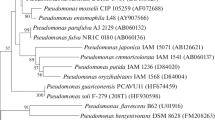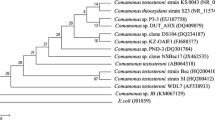Abstract
4-(Methylmercapto)-phenol (MMP) and 4-(methylsulfinyl)-phenol (MSP) are oxidized by the soil isolate Nocardia spec. DSM 43251, which is closely related to Nocardia calcarea. The rate of degradation depends on the capability of a substrate to support growth and is strongly enhanced in the presence of a second carbon source under the conditions of cooxidation. MMP and MSP are cometabolized by hydroxylation of the benzene ring with the formation of the substituted catechol following by ring cleavage between carbon atoms 2 and 3 (“meta”fission) to give 2-hydroxy-5-methylmercapto-or 2-hydroxy-5-methylsulfinylmuconic semialdehyde. Oxidation of MMP to MSP represents a bypath of MMP-oxidation. The intermediates were identified on the basis of their physical properties. The enzymes responsible for the metabolism of MMP and MSP are induced by growth with MMP or MSP, but not with glucose. MMP- and MSP-induced cells catalyze the oxidation of a variety of substituted phenols. This indicates a rather low substrate specificity of the enzymes induced by MMP and MSP.
Similar content being viewed by others
Abbreviations
- MMP:
-
4-(methylmercapto)-phenol
- MSP:
-
4-(methylsulfinyl)-phenol
- 3M-4MMP:
-
3-(methyl)-4-(methylmercapto)-phenol
- MMC:
-
4(methylmercapto)-catechol
- MSC:
-
4-(methylsulfonyl)-catechol
- MSV:
-
4-(methylsulfinyl)-veratrol
- MSOP:
-
4-(methylsulfonyl)-phenol
- MM-HMSA:
-
2-hydroxy-5-methylmercaptomuconic semialdehyde
- MS-HMSA:
-
2-hydroxy-5-methylsulfinylmuconic semialdehyde
- HMSA:
-
2-hydroxymuconic semialdehyde
- d6-DMSO:
-
deuterated dimethylsulfoxide
- CDCI3 :
-
deuterochloroform
- tlc:
-
thin layer chromatography
References
Buchanan, R. E., Gibbons, N. E. (eds.): Bergey's manual of determinative bacteriology, 8th ed. Baltimore: Williams & Wilkins 1974
Bull, D. L., Whitten, C. J., Ivie, G. W.: Fate of O-ethyl-O-[4-(methylthio)phenyl]-Spropyl phosphorodithioate (BAYNTN 9306) in cotton plants and soil. J. Agr. Food Chem. 24, 601–605 (1976)
Chapman, P. J.: An outline of reaction sequences used for the bacterial degradation of phenolic compounds. In: Degradation of synthetic organic molecules in the biosphere, Proceedings of a conference, pp. 17–55, Natl. Acad. Sci., Washington, D.C. (1972)
Dagley, S., Evans, C., Ribbons, D. W.: New pathways in the oxidative metabolism of aromatic compounds by microorganisms. Nature (Lond.) 188, 560–566 (1960)
Dagley, S., Gibson, D. T.: The bacterial degradation of catechol. Biochem. J. 95, 466–474 (1965)
DeBaun, J. R., Menn, J. J.: Sulfoxide reduction in relation to organophosphorus insecticide detoxification. Science 191, 187–188 (1976)
Eistert, B., Regitz, M., Heck, G., Schwall, H.: Methoden zur Herstellung und Umwandlung von aliphatischen Diazoverbindungen. In: Methoden der organischen Chemie, S. 473–893 (Houben-Weyl, Hrsg.). Stuttgart:Thieme 1968
Engelhardt, G., Wallnöfer, P. R., Hutzinger, O.: The microbial metabolism of di-n-butyl phthalate and related dialkyl phthalates. Bull. Environ. Contam. Toxicol. 13, 342–347 (1975)
Engelhardt, G., Wallnöfer, P. R., Rast, H. G., Fiedler, F.: Metabolism of o-phthalic acid by different Gram-negative and Grampositive soil bacteria. Arch. Microbiol. 109, 109–114 (1976)
Evans, W. C.: Microbial transformations of aromatic compounds. In: Fermentation advances, pp. 649–679 (D. Perlman, ed.). New York: Academic Press 1969
Farr, D. R., Cain, R. B.: Catechol oxygenase induction in Pseudomonas aeruginosa. Biochem. J. 106, 879–885 (1968)
Feist, C. F., Hegeman, G. D.: Phenol and benzoate metabolism by Pseudomonas putida: Regulation of tangential pathways. J. Bact. 100, 869–877 (1969)
Fest, C., Schmidt, K. J. (ed.): The chemistry of organophosphorus pesticides. Berlin-Heidelberg-New York:Springer 1973
Foster, J. W.: Bacterial oxidation of hydrocarbons. In: Oxygenases, pp. 241–271 (O. Hayaishi, ed.). New York: Academic Press 1962
Hayaishi, O.: Enzymic hydroxylation. Ann. Rev. Biochem. 38, 21–44 (1969)
Hegeman, C. D.: Synthesis of enzymes of the mandelate pathway in Pseudomonas putida. I. Synthesis of enzymes by the wild type. J. Bact. 91, 1140–1151 (1966)
Hutzinger, O., Wallnöfer, P. R.: Microbial transformations of pesticides. In: Handbook of microbiology, Vol. IV (L. Lechevalier, ed.), pp. 459–502. Cleveland: CRC-Press 1974
Kojima, N., Itada, Y., Hayaishi, O.: Metapyrocatechase: A new catechol-cleaving enzyme. J. biol. Chem., 236, 2223–2228 (1961)
Lowry, O. H., Rosebrough, N. J., Farr, A.L., Randall, R. J.: Protein measurement with the Folin phenol reagent. J. biol. Chem. 193, 265–275 (1951)
Munnecke, D. M. M., Hsieh, D. P. H.: Pathways of microbial metabolism of parathion. Appl. Microbiol. 31, 63–69 (1976)
Nozaki, M., Kotani, S., Ono, K., Senoh, S.: Metapyrocatechase. III. Substrate specificity and mode of ring fission. Biochim. biophys. Acta (Amst.) 220, 213–223 (1970)
Ornston, L. N.: Regulation of catabolic pathways in Pseudomonas. Bact. Rev. 35, 87–116 (1971)
Raymond, R. L., Jamison, V. W., Hudson, J. O.: Microbial hydrocarbon cooxidation. I. Oxidation of mono- and dicylic hydrocarbons by soil isolates of the genus Nocardia. Appl. Microbiol. 15, 357–365 (1967)
Ripin, M. J., Cook, T. M., Noon, K. F., Stark, L. E.: Bacterial metabolism of arylsulfonates: Role of meta-cleavage in benzene sulfonate oxidation by Pseudomonas testosteroni. Appl. Microbiol. 29, 382–387 (1975)
Rothera, A. C. H.: Note on the sodium nitro-prusside reaction for acetone. J. Physiol. (Lond.) 37, 491–494 (1908)
Sala-Trepat, J. M., Evans, W. C.: The meta cleavage of catechol by Azotobacter species. 4-Oxalocrotonate pathway. Europ. J. Biochem. 20, 400–413 (1971)
Seidman, M. M., Toms, A., Wood, J. M.: Influence of side-chain substituents on the position of cleavage of the benzene ring by Pseudomonas fluorescens. J. Bact. 97, 1192–1197 (1969)
Stanier, R. Y., Palleroni, N. J. Doudoroff, M.: The aerobic pseudomonads: A taxonomic study. J. gen. Microbiol. 43, 159–171 (1966)
Tabak, H. H., Chambers, C. W., Kabler, P. W.: Microbial metabolism of aromatic compounds. J. Bact. 87, 910–919 (1964)
Takase, J., Yoshimoto, Y.: The metabolic behaviour of fenthion and fensulfothion in flooded soil. Bayer Report No. 1037 (1975)
Teuber, M.: Release of the periplasmic penicillinases from Escherichia coli by toluene. Arch. Mikrobiol. 73, 61–64 (1970)
Waggoner, T. B., Khasawinah, A. M.: New aspects of organophosphorus pesticides. In: Residue reviews, Vol. 53 (F. A. Gunther, ed.), pp. 79–97. Berlin-Heidelberg-New York: Springer 1974
Author information
Authors and Affiliations
Rights and permissions
About this article
Cite this article
Engelhardt, G., Rast, H. & Wallnöfer, P. Bacterial metabolism of substituted phenols. Arch. Microbiol. 114, 25–33 (1977). https://doi.org/10.1007/BF00429626
Received:
Issue Date:
DOI: https://doi.org/10.1007/BF00429626




